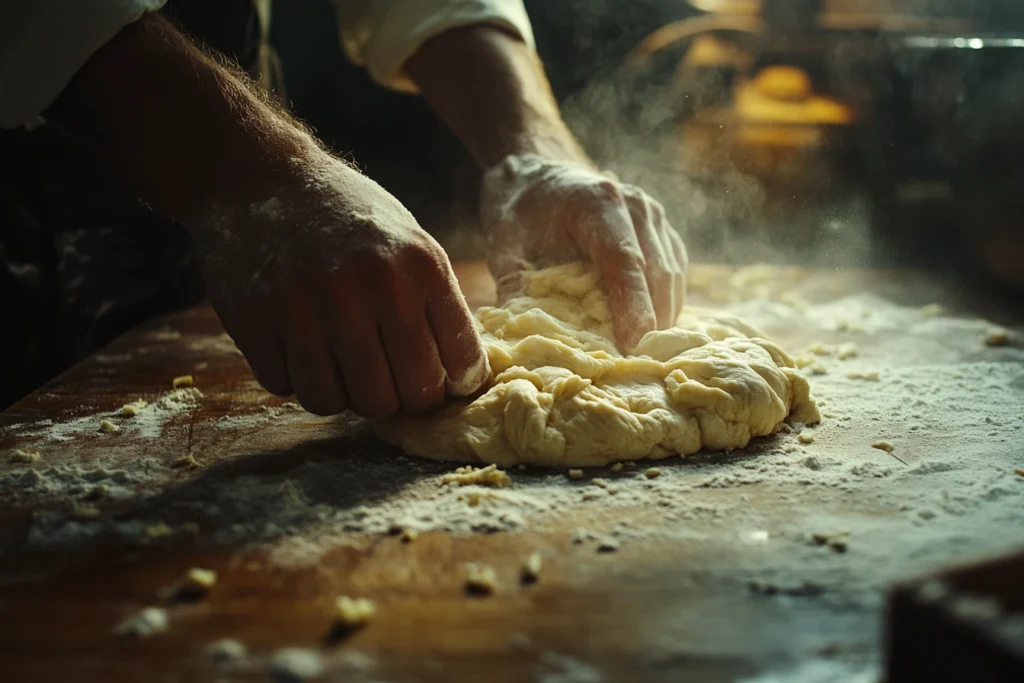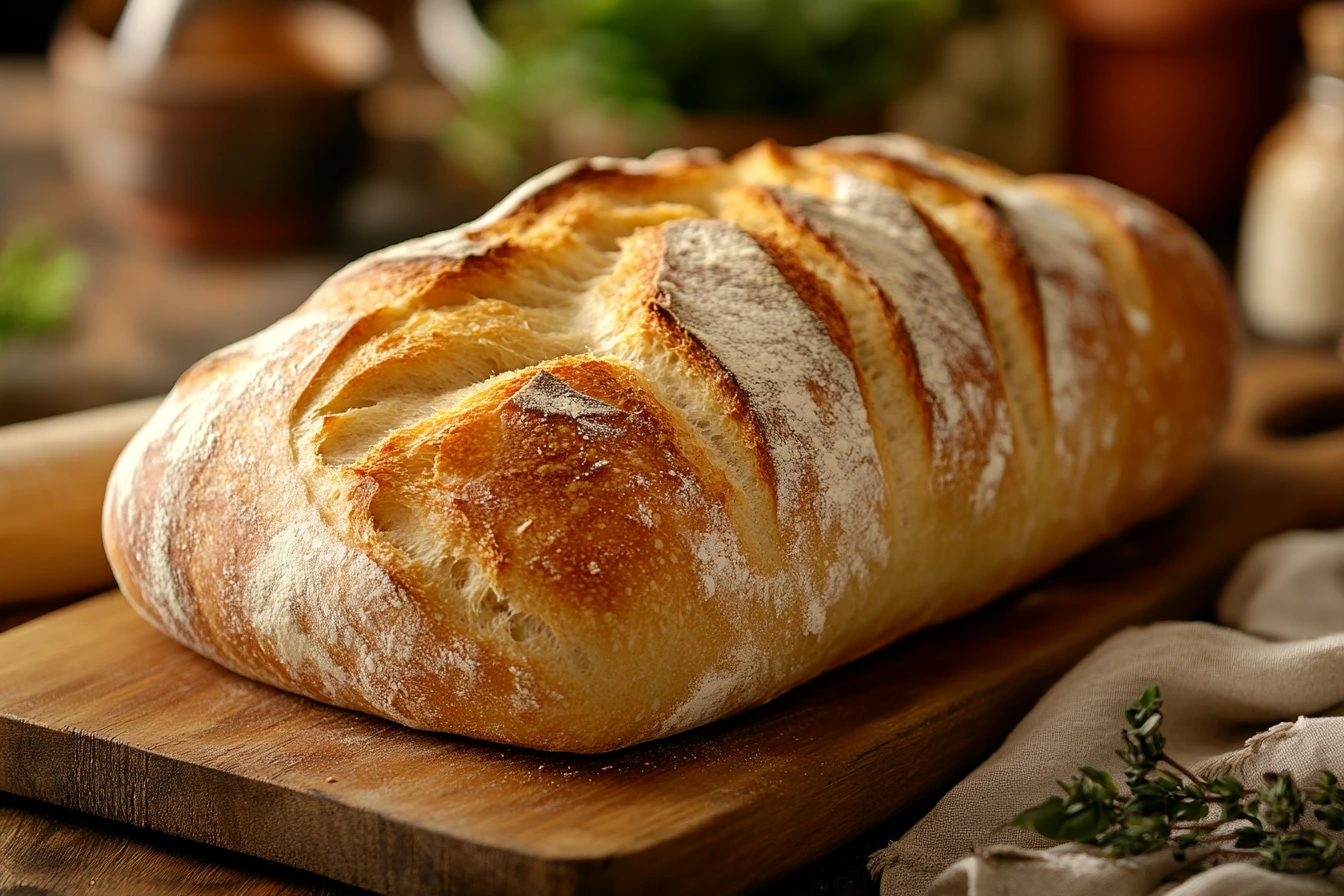Few things are as satisfying as the aroma of freshly baked bread filling your kitchen. Whether you’re a seasoned baker or a beginner, making Italian bread recipe from scratch is a rewarding experience. With its crispy crust, soft interior, and rustic charm, this bread pairs perfectly with soups, pasta, or simply a drizzle of olive oil.
In this guide, we’ll take you through a foolproof Italian bread recipe, covering everything from ingredients and techniques to baking tips and variations. Plus, we’ll share insider tricks to get that golden, bakery-style crust at home.
Table of Contents
So, let’s roll up our sleeves and start baking!
Introduction to Italian Bread Recipe
What Makes Italian Bread Special?
Italian bread isn’t just about taste it’s about tradition. Unlike French baguettes, which have a crispier crust and airier crumb, Italian bread is known for its slightly softer texture, golden crust, and richer flavor. The secret? A bit of olive oil, a different baking process, and a focus on artisanal simplicity.
What sets Italian bread apart?
✔️ Thicker crust – Not as hard as a baguette, but still crunchy.
✔️ Softer, chewy crumb – Thanks to the right hydration level.
✔️ Olive oil magic – Adds flavor and moisture to the dough.
✔️ Endless versatility – Perfect for bruschetta, paninis, or dipping into sauces.
Why You Should Try This Recipe
You don’t need a fancy bread machine or a wood-fired oven to make amazing Italian bread at home. This Italian bread recipe is:
- Beginner-friendly – No complicated techniques, just easy steps.
- Made with simple pantry staples – Flour, water, yeast, salt, and olive oil.
- Customizable – Add herbs, cheese, or even garlic for an extra kick.
- Better than store-bought – Fresher, tastier, and with no preservatives!
Plus, nothing beats the satisfaction of pulling a warm, golden loaf out of the oven. 🍞✨
However, if you’re interested in homemade bread, you might enjoy their Amish Bread Recipe—a soft and slightly sweet bread that’s perfect for breakfast or snacking.
Essential Ingredients for Authentic Italian Bread recipe
The Key Ingredients & Their Roles
Making a perfect Italian bread recipe starts with high-quality ingredients. Each component plays a vital role in shaping the flavor, texture, and rise of the bread.
- Flour – The backbone of any bread recipe. Using the right flour ensures the perfect balance of chewiness and structure.
- Yeast – The magic ingredient that makes the dough rise! Active dry yeast or instant yeast both work, but fresh yeast adds a more authentic bakery-style flavor.
- Water – Hydration is key! The right amount of water helps develop the gluten structure, making the bread soft inside and crisp outside.
- Salt – A small amount enhances the flavor while controlling yeast activity.
- Olive Oil – Unlike French bread, Italian bread often includes extra virgin olive oil, which adds richness and moisture.
What is the Best Flour to Use for Italian Bread recipe?
Using the right flour makes a huge difference in the final texture of your bread.
- Bread Flour – With a high protein content, it gives the bread a chewier, more structured texture.
- All-Purpose Flour – Works well for a softer, less chewy bread.
- Tipo 00 Flour – The gold standard in Italy, it creates a fine, delicate crumb with a slight chew.
For the best homemade Italian bread recipe, bread flour or Tipo 00 is recommended for that signature chewy yet airy texture.
Step-by-Step Guide to Making Italian Bread recipe
Preparing the Dough

Making Italian bread is all about simplicity and technique. Follow these steps for a perfect loaf:
- Activate the yeast: In a bowl, mix warm water, yeast, and a pinch of sugar. Let it sit for 5–10 minutes until it becomes foamy.
- Mix the dry ingredients: In a large bowl, combine flour and salt.
- Combine everything: Slowly add the yeast mixture and olive oil, then mix until a rough dough forms.
- Knead the dough: On a floured surface, knead for 8–10 minutes until smooth and elastic.
The Fermentation & Proofing Process
Letting the dough rise is crucial to developing the right texture and flavor.
- First rise: Place the dough in a greased bowl, cover it with a damp towel, and let it rise for 1–2 hours until doubled in size.
- Shaping the dough: Gently deflate the dough and shape it into a round or long loaf, depending on your preference.
- Second rise: Let the shaped dough rest for another 30–45 minutes before baking.
This double-proofing method ensures your Italian bread recipe has a light, airy texture inside and a crispy golden crust outside.
However, if you’re interested in homemade bread, you might enjoy their Amish Bread Recipe—a soft, slightly sweet bread that’s great for breakfast or snacking.
Now, let’s continue with Part 4 and Part 5 of the article!
Baking Italian Bread recipe to Perfection
How to Achieve a Crispy, Golden Crust
One of the signature features of an Italian bread recipe is its beautifully golden, slightly crispy crust. Achieving this texture requires a few simple baking tricks:
- Preheat Your Oven Properly – Italian bread bakes best at 425°F (220°C) for the perfect balance of crispiness and softness.
- Use Steam for a Crispy Exterior – Professional bakers use steam to help bread develop a crackly crust. You can replicate this at home by:
- Placing a pan of hot water on the oven’s bottom rack.
- Spritzing the loaf with water before and during baking.
- Bake on a Pizza Stone or Baking Steel – These help create an even bake and a crisp bottom crust.
With these techniques, your Italian bread will turn out golden, crispy, and full of authentic flavor!
Cooling and Storing Fresh Italian Bread
Once your bread is baked to perfection, cooling it properly ensures the best texture.
- Let the bread rest on a wire rack for at least 20–30 minutes to allow the crumb to set.
- Avoid slicing the bread while it’s too hot—this can make the interior gummy.
- Store leftover bread in a paper bag or a bread box to maintain freshness while keeping the crust crisp.
For longer storage, you can freeze Italian bread for up to 3 months. Just wrap it tightly in plastic wrap and place it in a freezer bag.
Flavor Variations & Regional Styles
Different Types of Italian Bread
Italy is home to many types of bread, each with its unique characteristics. Here are a few popular varieties:
- Ciabatta – A rustic, airy bread with large holes, perfect for sandwiches.
- Focaccia – A soft, dimpled bread drizzled with olive oil, often topped with herbs.
- Pane Toscano – A traditional Tuscan bread made without salt, ideal for dipping in flavorful sauces.
- Filone – A simple Italian loaf similar to a baguette, with a chewy texture.
How to Customize Your Italian Bread Recipe
Want to enhance the flavor of your homemade bread? Try these creative twists:
- Herbed Italian Bread – Add rosemary, thyme, or oregano to the dough for a fragrant loaf.
- Cheese-Stuffed Bread – Mix in shredded Parmesan or mozzarella for extra richness.
- Olive & Garlic Bread – Fold in chopped olives and roasted garlic for a Mediterranean touch.
- Whole Wheat Variation – Swap part of the flour with whole wheat flour for a heartier texture.
By experimenting with different ingredients, you can create a unique and flavorful Italian bread that suits your taste!
Common Mistakes & Troubleshooting Tips
Even with a simple Italian bread recipe, mistakes can happen. If your bread didn’t rise properly or the texture feels off, don’t worry! Here’s how to fix the most common problems.
Why Didn’t My Bread Rise Properly?
If your dough isn’t rising as expected, a few things could be the culprit:
- Inactive Yeast – Check if your yeast is fresh. If it doesn’t foam after mixing with warm water and sugar, it’s likely expired.
- Too Cold of an Environment – Yeast thrives in warmth. If your kitchen is cold, place the dough in a slightly warm oven (turned off) or near a sunny window.
- Too Much Salt – Salt can slow down yeast activity. Make sure you’re using the correct ratio.
A good rise is essential for achieving light and airy Italian bread, so always check your yeast and proofing conditions!
How to Avoid a Dense or Gummy Texture
A dense loaf is often caused by one of these common mistakes:
- Over or Under Kneading – Kneading builds gluten, which gives bread structure. If under-kneaded, the bread won’t have enough strength to rise properly. If over-kneaded, it may become too tight. Aim for 8-10 minutes of kneading until the dough is smooth and elastic.
- Skipping the Second Rise – This step allows the dough to expand fully, leading to a lighter texture. Always let the shaped loaf rest before baking.
- Too Much Flour – Adding too much flour during kneading can make the dough too stiff. The dough should be soft and slightly sticky.
By avoiding these mistakes, your Italian bread recipe will turn out light, airy, and full of flavor every time!
Serving Italian Bread the Italian Way

Do Italians Put Olive Oil on Their Bread?
Yes, but not in the way you might think! While Italians love extra virgin olive oil, they typically don’t dip their bread into it like in American restaurants. Instead, olive oil is drizzled over bread, especially when making bruschetta or focaccia.
For an authentic experience, try:
- Bruschetta – Toast slices of Italian bread, rub with garlic, and drizzle with olive oil. Add tomatoes and basil for extra flavor.
- Pane e Olio – Simply drizzle high-quality extra virgin olive oil over fresh bread and sprinkle with sea salt.
Best Ways to Enjoy Homemade Italian Bread
This Italian bread recipe is incredibly versatile! Here are a few classic ways to serve it:
- With Pasta – Use it to soak up rich sauces like marinara or Alfredo.
- For Paninis – Slice the bread and fill it with cheese, cured meats, and fresh veggies, then grill to perfection.
- Dipped in Soup – Serve it alongside minestrone, Tuscan bean soup, or tomato basil soup.
- As Garlic Bread – Spread butter, minced garlic, and herbs on the bread before toasting for a savory side dish.
With so many ways to enjoy it, this Italian bread recipe is perfect for any meal!
Storing and Freezing Homemade Italian Bread
Freshly baked Italian bread tastes amazing, but proper storage ensures it stays delicious for longer. Whether you’re keeping it for a day or freezing it for later, here’s how to do it right.
Keeping Italian Bread Fresh Longer
Italian bread has a crisp crust and a soft interior, so storing it correctly helps maintain its texture.
- Room Temperature Storage – Store bread in a paper bag or wrap it in a clean kitchen towel. This keeps the crust crisp while preventing it from drying out.
- Avoid Plastic Bags – While plastic bags keep bread soft, they can also make the crust soggy due to trapped moisture.
- Best Shelf Life – Italian bread stays fresh at room temperature for 2-3 days.
If your bread starts to go stale, revive it by placing it in a 350°F (175°C) oven for 5-7 minutes. This will crisp up the crust and restore freshness!
How to Freeze & Reheat Italian Bread
Freezing is the best way to extend the life of homemade bread. Follow these steps for the best results:
- Let the bread cool completely before freezing to prevent condensation and sogginess.
- Wrap it tightly in plastic wrap, then place it in a freezer bag or airtight container.
- Label it with the date and freeze for up to 3 months.
To reheat frozen Italian bread:
- Whole Loaf – Let it thaw at room temperature, then warm in the oven at 350°F (175°C) for 10-15 minutes.
- Sliced Bread – Toast slices directly from frozen or microwave for 15-20 seconds.
With proper freezing and reheating, your Italian bread recipe will always taste fresh!
Frequently Asked Questions
1. What Makes Italian Bread Different?
Italian bread stands out because of its variety, texture, and ingredients. Unlike French bread, which tends to have a thinner, crisper crust, Italian bread recipes vary from soft and fluffy loaves to rustic, crusty varieties.
Another key difference is the use of olive oil, which adds a distinct flavor and keeps the bread moist. Some regional Italian breads, like pane Toscano, even omit salt for a milder taste that pairs well with salty dishes.
2. What Gives Italian Bread Its Unique Flavor?
Several factors contribute to the unmistakable taste of authentic Italian bread:
✔ Long fermentation: Enhances flavor and texture, especially when using a sourdough starter.
✔ Olive oil: Adds a rich, slightly fruity taste.
✔ High-quality flour: Affects texture and depth of flavor.
✔ Traditional baking methods: Using a pizza stone or Dutch oven creates a superior crust.
For an extra boost, many bakers use fermented dough starters to create deeper, more complex flavors.
3. What is the Best Flour to Use for Italian Bread?
The ideal flour depends on the type of Italian bread you’re making:
- Bread flour: Best for chewy, crusty loaves due to its high protein content.
- Tipo 00 flour: Traditional for soft Italian breads like focaccia or ciabatta.
- Semolina flour: Adds richness and a slightly nutty flavor to rustic loaves.
- Whole wheat flour: Used for healthier variations with a denser texture.
For best results, use unbleached flour, as it retains more of the wheat’s natural flavor.
4. Do Italians Put Olive Oil on Their Bread?
Yes! Italians frequently drizzle extra virgin olive oil on their bread, but not in the same way as in American restaurants. While it’s common to dip bread in olive oil in the U.S., Italians prefer to brush olive oil onto toasted bread or mix it with garlic and herbs for an extra layer of flavor.
In southern Italy, pane casareccio (homemade bread) is often served with olive oil, fresh tomatoes, and oregano, creating a simple yet delicious snack.

